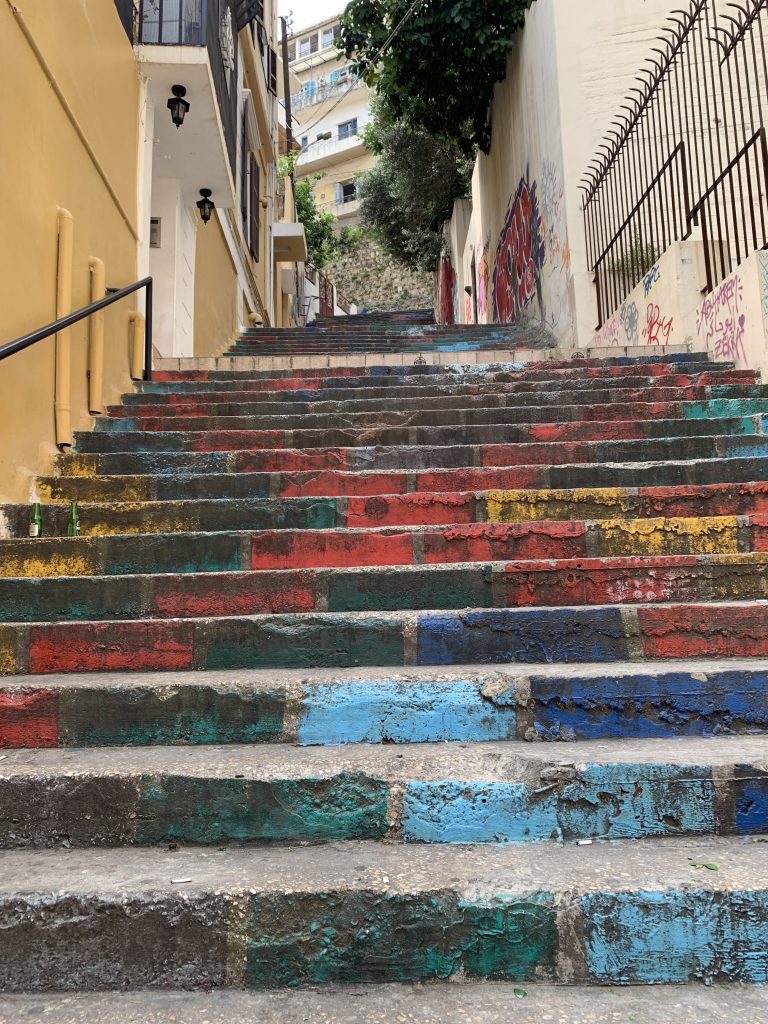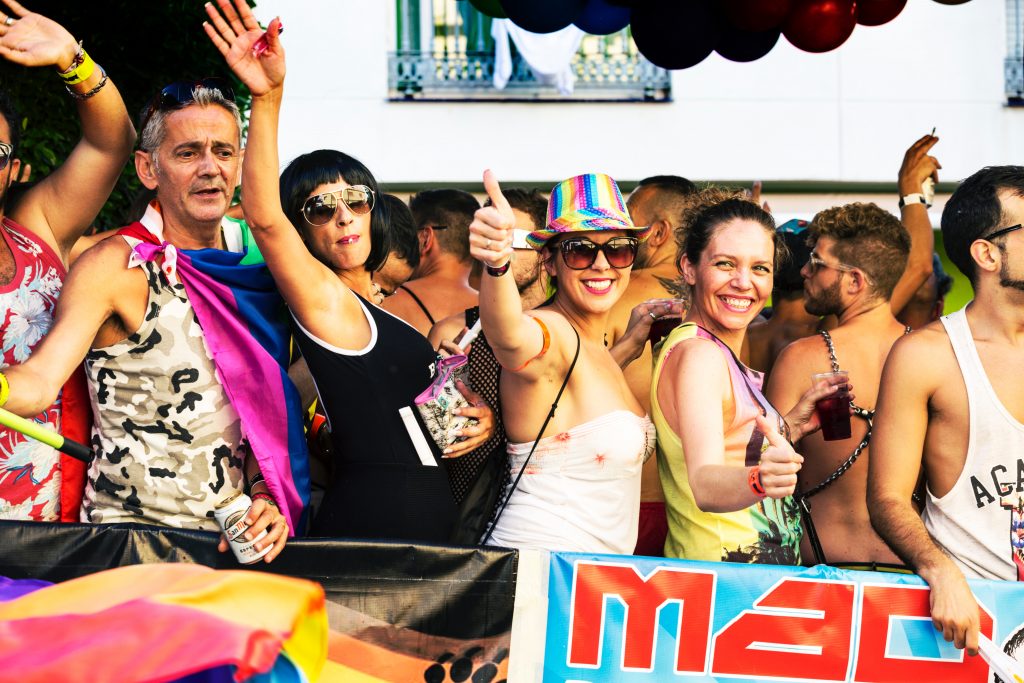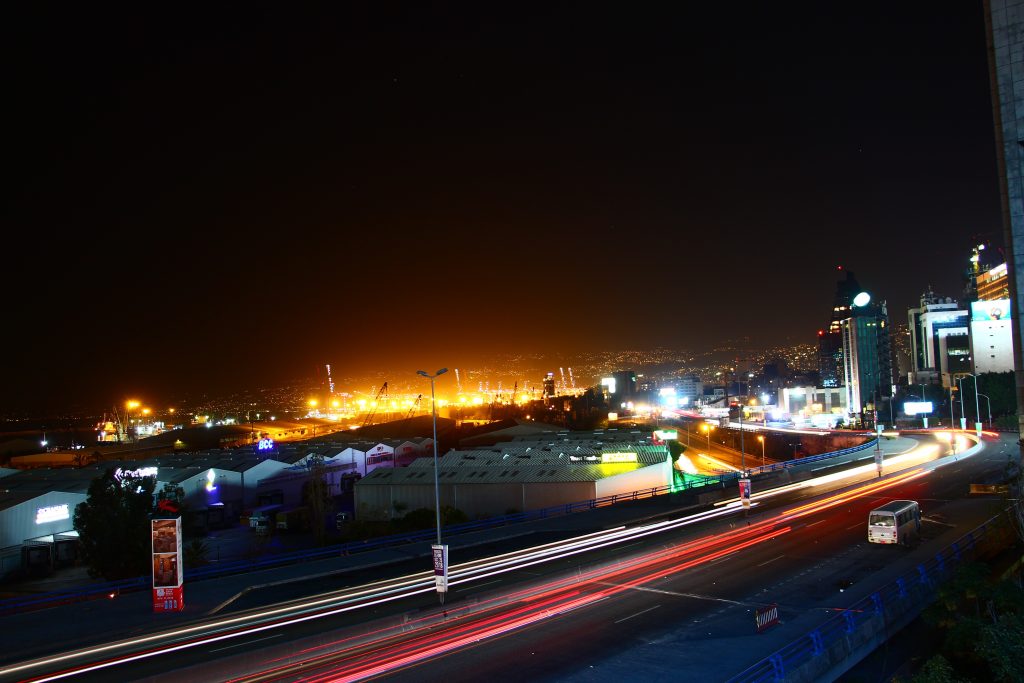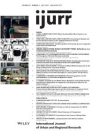How do we gauge the gay and queer potential of cities and urban spaces? What do designations of gay-friendliness do, or set in motion? Is gay-friendliness a useful framework for understanding “gay life” in cities? In this piece, I draw from my research on everyday life disruptions and queer strategies in Beirut to challenge how “gay spaces” have been used to provide exceptional narratives about cities. I offer my concept of “fractal Orientalism” or Orientalisms within the so-called Middle East, to address how popular media and some academic studies reproduce frameworks that rely on narrow assumptions about what gay and gay-friendly spaces are or entail. Academic studies and journalistic accounts that address queer urban spaces almost exclusively explore gay-male-dominated spaces in major cities and metropolitan centers. Moreover, existing literature privileges gay spaces in the global north, particularly Euro-American cities, although more recently there has been a move to explore these spaces (or the potential of such spaces) in the global south.

Mar Mikhael district, Beirut. Photo: Ghassan Moussawi.
The process of queering urban space in the global south has often meant using cosmopolitan urban centers in the global north as universal reference points. For example, Beirut has been called the Paris of the Middle East, the San Francisco of the Arab World, and more recently the Provincetown of the Middle East. As a journalistic practice, cities in the global south are made intelligible to Euro-American audiences by comparing and contrasting them to Euro-American cities and other cities in the global south. To examine gay spaces, popular media (and some academic studies) often explore the presence of gayborhoods, gay bars, and nightlife that resemble those in Europe and North America. In addition, they look for the presence of “out” LGBT NGOs, mainstream gay visibility, and LGBT-organizing strategies that primarily focus on pride and coming out. For example, the international gay tour-guide Spartacus International, describes Beirut as gay-friendly, by claiming that: “gay bars and clubs operate freely and an LGBTQ centre has been created to cater to all needs of the [gay] community” (2016, 482).
Many journalists and some academics in Europe and North America appear to regard gay spaces in the global south as exceptional by virtue of being located in the global south. Journalists see these gay or gay-friendly spaces as exceptional vis-à-vis some imagined transregional landscape of “gay space” in Euro-American cities—which they often regard as the norm and others as the exception. Thus, they expect gay spaces in the global south to resemble those in the global north (gay bars and rainbow flags), and often imply a unilinear model of the development of “gay space”, with cities in the south following the example set by those in the north.
For example, in a New York Times article in 2009, journalist Patrick Healy names Beirut “the Provincetown of the Middle East,” for its seemingly “nascent” gay life, while distancing it from other (homophobic) cities in the Arab world. To mark “gay life” in parts of the global south as “new” erases local histories of queer spaces. In addition, it centers white gay formations in Euro-American cities such as Provincetown as a metric to make cities in the global south intelligible to Euro-American audiences. The concept of a place being labeled “gay-friendly” often exists through a relational comparison to spaces perceived not to be gay-friendly. Beirut is hailed as “the Arab world’s most gay friendly city,” “the gay paradise of the Arab World,” promising to “represent a different Middle East for some gay and lesbian Arabs.” Beirut becomes “gay friendly,” as it is simultaneously compared to and distanced from both Euro-American cities, and the rest of the presumed homophobic Arab and Muslim world. Healy (2009: 3) claims, “Beirut represents a different Middle East for some gay and lesbian Arabs: the only place in the region where they can openly enjoy a social life denied them at home”. Spartacus International claims more explicitly that Beirut is “the largest city and the most liberal urban centre in the country, the last big city in European terms before the desert” (2011, 578).
Such an approach overlooks a number of issues: first, it assumes a homogenous spatial formation of “gay space” that is based on an imagined (white) Euro-American urban universal and that uses linear narratives of progress – where Euro-American cities are seen as “liberal”. Second, it glosses over the exclusionary nature of white gay spaces everywhere – especially when it comes to race, gender, and class – and more often than not elides the political economies of gay space. Finally, this approach collapses “gay” and “queer,” and uses them interchangeably.

Pride parade. Photo: Quino Al.
Are gay spaces really exceptional?
Despite the vast literature that has shown that gay spaces in Euro-American cities tend to be exclusionary – white, middle-class, and gender-normative spaces – we still seek to find them in urban settings and employ them as signs of a society’s “progressiveness.” This reproduces assumptions that cities themselves are progressive, “open,” and “tolerant” to difference. Moreover, mainstream gay spaces (such as bars, pride parades, etc.) are treated as signs of “progress,” and “equality,” while in fact, their presence is always contested based on the multiple exclusions that constitute and are constitutive of them. Gay spaces, in and of themselves, do not tell us much about “progress.” Within Euro-American cities, queer people of color have historically created – and continue to create – their own spaces (such as dance parties and activist circles) that do not get accounted for when writing about “gay spaces,” or the “gay friendliness” of cities. Perceptions of Beirut and its gay spaces, such as those represented by Healy and others, present a prime example of this flawed logic. In my forthcoming book, Disruptive Situations: Fractal Orientalism and Queer Strategies in Beirut, I argue that representations of Beirut as gay-friendly are made possible through what I call “fractal Orientalism.” Unlike classic Orientalism, which uses simple binaries of East and West, fractal Orientalism is multi-scalar and employs nested binaries to simultaneously produce the same distinctions of West/East on multiple levels. Fractals or “nested dichotomies” as analytics are multi-scalar. Thus, fractal Orientalism simultaneously operates on multiple scales of hemisphere, nation/state, urban/rural, and neighborhood. For example, it represents the West as more progressive than the Middle East, even as it represents Lebanon as more “progressive” than other Arab Middle Eastern countries, and Beirut as more “gay-friendly” than the rest of Lebanon. These distinctions extend to classify different areas within Beirut, representing neighborhoods that are predominantly Muslim as less open than their Christian counterparts. Moreover, it regards secularists and Christians as more “appropriate gay subjects” than Muslims. Applied elsewhere, fractals distinguish between rural and urban spatial formations, representing gay-friendliness as unique to certain urban spaces.
Fractal Orientalism reveals how cities are often compared and contrasted to one other when designating gay spaces. As a practice, it distances Beirut from both its Euro-American and Arab counterparts—its gay life is not exactly that of Paris, yet it is not Amman nor Damascus. For example, Dutch reporter Jurriaan Tuelings (2010) claims: “At the city’s two main gay clubs, Milk and Acid, a mix of Lebanese, Syrian, Jordanian, Kuwaiti and even some Iraqi men disprove any remaining theory of cultural relativism. That is to say, once inside people don’t behave differently from any other gay club in the world – with the possible exception of the occasional male belly dance. But this being the Middle East, most of the men are closeted” (103, emphasis added). Leaving geographical context aside, Beirut might not be as exceptional as it is represented.
When journalists assume that the existence of “gay-friendly” spaces is synonymous with societal openness and progress, they risk erasing or ignoring exclusionary state practices around non-normative and minoritized populations. For example, when they describe Beirut as open and “tolerant” to difference, they do not account for its racist, sexist, and xenophobic realities and policies – particularly against Syrian and Palestinian refugees, working-class individuals, and gender non-normative and trans people. This flattened perception of Beirut’s openness to “diversity” obscures the political economy of gay spaces. Approaching gay spaces through the lens of political economy centralizes who has access to such spaces, such as those who can pay. In addition, it pays attention to which populations are usually targeted by the state. For example, in the 2013 police raid and closing of the gay club Ghost in Beirut, police detained, humiliated, and verbally and physically abused several gay and trans individuals: most notably working-class and gender-nonnormative individuals, and Syrian nationals and refugees. Such accounts get erased in talking about “gay Beirut,” to the extent that Beirut’s “openness” to white gay travelers is made possible by such exclusionary practices against undesirable gendered, racialized, and classed others.

Beirut Skyline City View. Photo: Georg Auffarth.
Visibly gay space vs queering space
When we speak of the visibility of gay spaces, we fall into the trap of looking for mainstream understandings of white Euro-American conceptions of visibility (rainbow flags, gay businesses, pride parades, etc.). In my research, LGBT people in Beirut contest narratives of Euro-American gay visibility – predominately used in gay social movements– that assume that LGBT people and spaces are visible by virtue of their queerness. Instead, they argue that they are always already relationally visible based on their gender, religious sect, class, and which area or neighborhood they are in. Visibility, like queerness, is relational. It is not a goal in and of it itself.
Using “gay visibility” as a normative metric to assess the “gay-friendliness” of urban spaces assumes homogenous populations that are distinguished through their gayness. Such assumptions miss how visibility is also about the surveillance of spaces and the tracking of marginalized populations. Instead of looking for LGBT people in Beirut, it is more productive to think of everyday queer strategies that people employ in navigating cities. In Disruptive Situations, I contest fractal representations by focusing on LGBT peoples’ lived realities of navigating space. If “to queer” means to “interrupt,” to “spoil,” and to problematize (Somerville 2014, para 2), then looking for “visibly gay” spaces seems to reproduce normative assumptions of (white) gayness.
A focus on queer strategies reveals that the practice of queering space has the potential to think beyond the limits and traditional constructions of terms like “gay visibility” and “gay space.” In my work on queer strategies of everyday life in Beirut, I found that LGBT people use strategies such as embracing the city’s contradictions, resisting narratives of reconciliation, not positing gay visibility as a goal, and creating their own spaces (or what I call “bubbles”) that may or might not be physical spaces. These strategies vary based on gender, class, and neighborhoods. Perhaps a move towards people’s strategies of navigating space is a more useful framework to uncover the entanglements of “gay life,” state policies, and exclusionary practices. When we attend to the practices of the everyday, we also let go of exceptional narratives of cities.
Many LGBT people are not able to experience spaces as “gay-friendly.” Gay-friendly Beirut is accessible primarily to gender-normative, cisgender, and middle-to-upper-class LGBT people. Neoliberalism and gay-friendliness are indelibly intertwined to structurally shape and foster dominant discourses and practices of exclusion in Beirut. Accounts of exceptionalism promote dual narratives about cities and progress: one that presumes that LGBT-visibility and gay spaces are signs of progress; and the other that presumes Beirut is itself the more progressive city in the region. In turn, these narratives suppress the exclusionary and regulatory practices of the Lebanese state around race, gender, class, and citizenship.
Examining comparative studies of gay life and exceptional narratives of cities opens up the possibility to ask different sets of questions. When we move away from looking for gay space to examining queer strategies of navigating spaces in cities, we let go of an assumed homogeneity of LGBT spaces and people. Ultimately, comparing urban spaces fails to account for the queer potential of places. When we rely on simplistic metrics to account for gay spaces and lives, whose gay spaces are we privileging, and what spaces and practices might we overlook?
Ghassan Moussawi is Assistant Professor of Gender & Women’s Studies and Sociology at the University of Illinois at Urbana-Champaign. His forthcoming book (Temple University Press, 2020) “Disruptive Situations: Fractal Orientalism and Queer Strategies in Beirut,” focuses on everyday life disruptions and queer formations in post-war Beirut. His work has been published in Gender, Place, and Culture; Sexualities; The Sociological Review; and Introducing the New Sexualities Studies.
All essays on Queering Urban Studies
Introduction
Rivke Jaffe
The Fraught Nature of Exceptional Gay Spaces
Ghassan Moussawi
A Tale of Two Lexes: a Lesbian-Queer Anti-Assimilationist Approach to Queering Space
Jen Jack Gieseking
Queer Regenerations of Violence, from Berlin to Toronto
Jin Haritaworn
For the City ‘Not Yet Here’
Natalie Oswin
Sex Work is Urban
Kian Goh
Into and Beyond Death: Considering Transgender Justice in Urban Studies
Rae Rosenberg
Related IJURR articles on Queering Urban Studies
Women, urban social movements and the lesbian ghetto
Elizabeth M. Ettorre
Social theory, social movements and public policy: recent accomplishments of the gay and lesbian movements in Minneapolis, Minnesota
Lawrence Knopp
Gender and space: lesbians and gay men in the city
Sy Adler and Johanna Brenner
“Out” in the Valley
Ann Forsyth
Finding oneself, losing oneself: The lesbian and gay “scene” as a paradoxical space
Gill Valentine and Tracey Skelton
Journeys and returns: Home, life narratives and remapping sexuality in a regional city
Gordon Waitt and Andrew Gorman‐Murray
LGBTQs in the city, queering urban space
Yvonne P. Doderer
Relational Comparison and LGBTQ Activism in European Cities
Jon Binnie
LGBT neighbourhoods and “new mobilities”: Towards understanding transformations in sexual and gendered urban landscapes
Catherine J. Nash and Andrew Gorman‐Murray
“Wilding” in the West Village: Queer space, racism and Jane Jacobs hagiography
Johan Andersson
The trouble with flag wars: Rethinking sexuality in critical urban theory
David K. Seitz
A clash of subcultures? Questioning Queer–Muslim antagonisms in the neoliberal city
Kira Kosnick
Urban political ecologies and children’s geographies: Queering urban ecologies of childhood
Laura J. Shillington and Ann Marie F. Murnaghan
Urban politics as the unfolding of social relations in place: The case of sexually transmitted disease investigation in mid‐twentieth‐century gay Seattle
Larry Knopp, Michael Brown, and Will McKeithen
© 2019 THE AUTHOR. INTERNATIONAL JOURNAL OF URBAN AND REGIONAL RESEARCH, PUBLISHED BY JOHN WILEY & SONS LTD UNDER LICENSE BY URBAN RESEARCH PUBLICATIONS LIMITED
This is an open access article under the terms of the Creative Commons Attribution-NonCommercial-NoDerivs License, which permits use and distribution in any medium, provided the original work is properly cited, the use is non-commercial and no modifications or adaptations are made.
